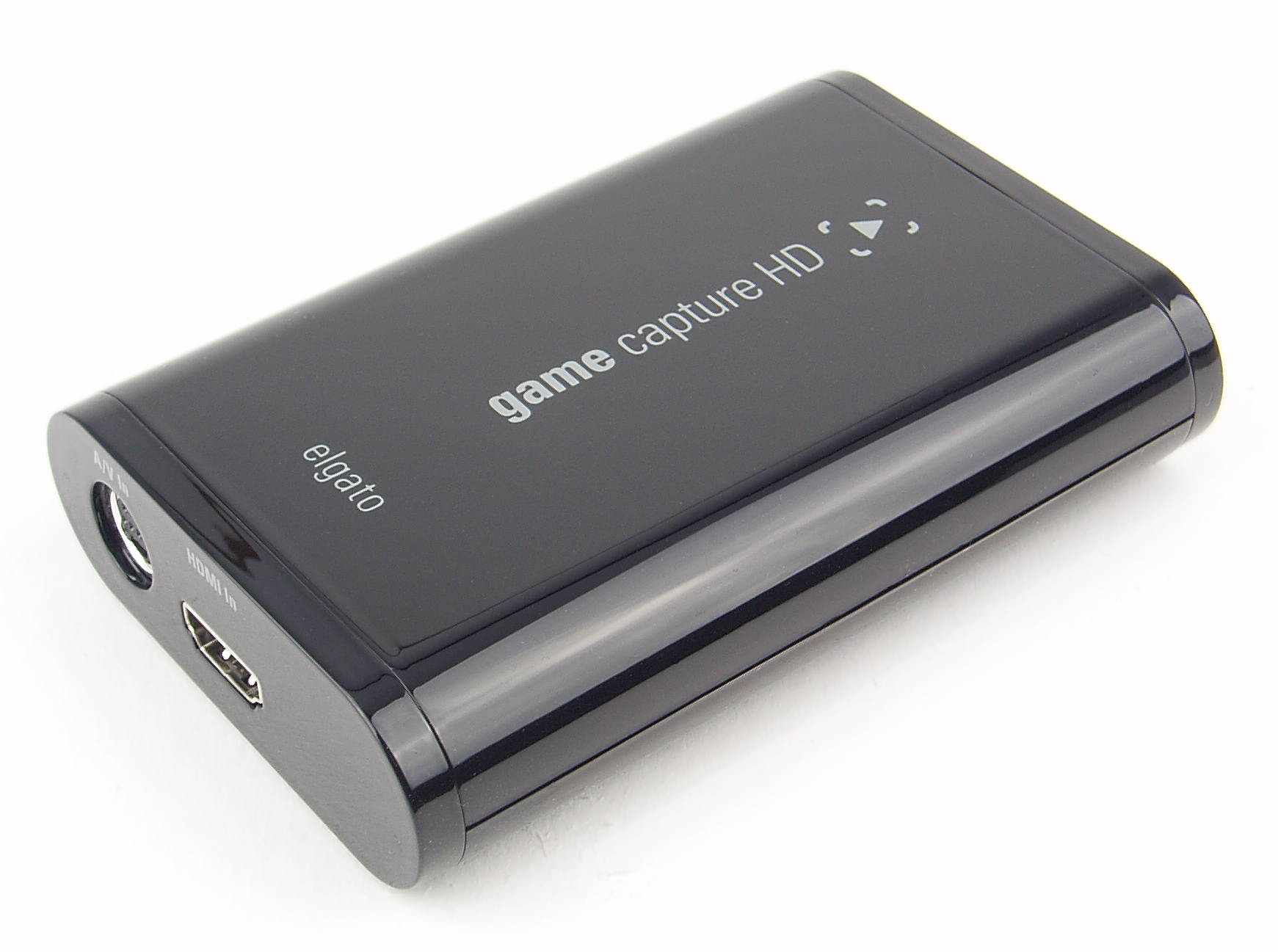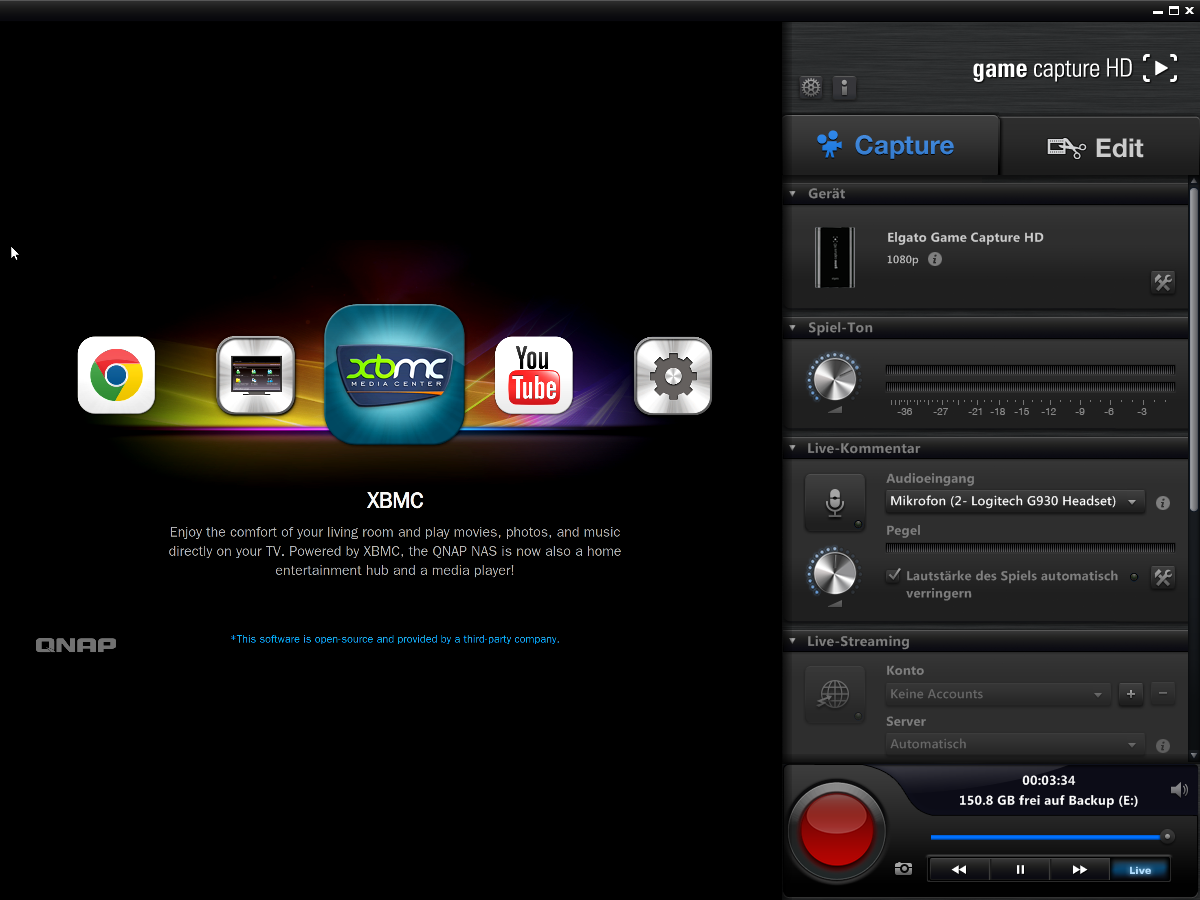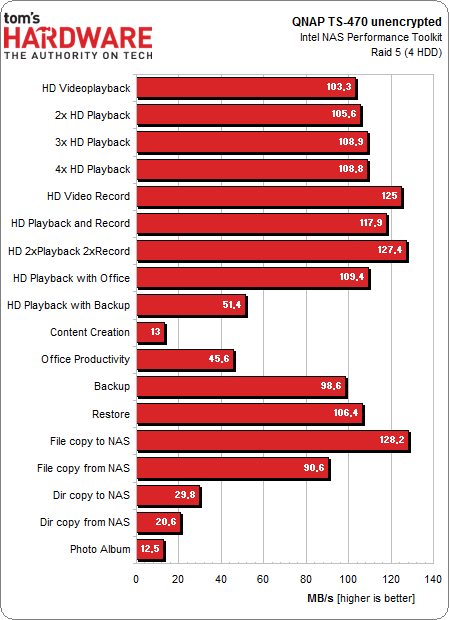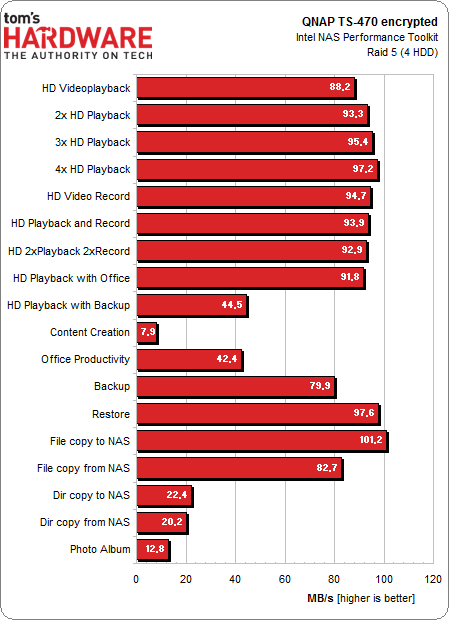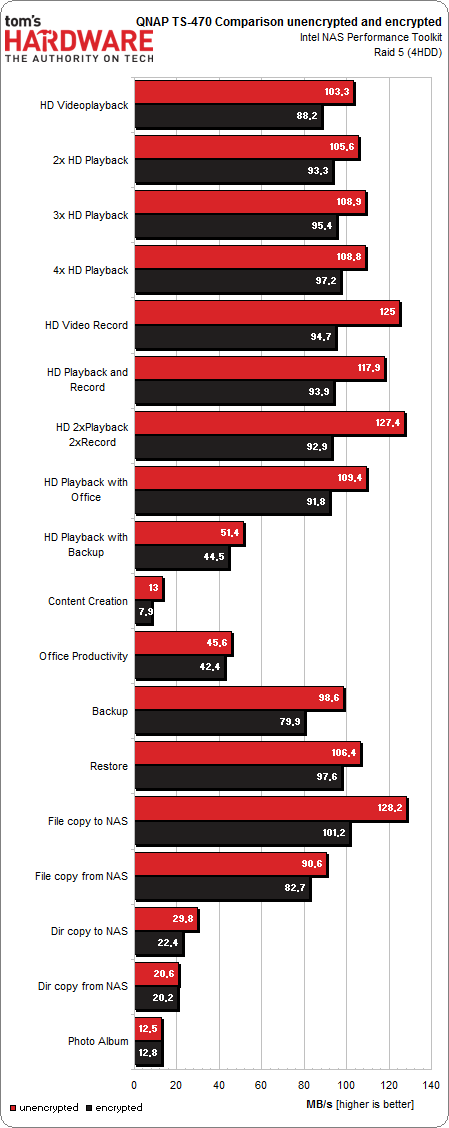QNAP TS-470 NAS Review: Four GbE Links, With 10 GbE Scalability
Armed with a Sandy Bridge-based Celeron CPU, QNAP's TS-470 handles the traffic from four gigabit Ethernet connections. Or, with the addition of a 10 GbE upgrade card, it can be made to push well over 1 GB/s, providing you use the right storage.
Testing QNAP's TS-470 NAS
QNAP sent us a review sample with four 4 TB Seagate ST4000VN000 hard drives already installed and configured in RAID 5, yielding 12 TB of accessible capacity. The internal file system is ext4, and our TS-470 came with QTS version 4.0.5 installed, dated 10-23-13.
| Test Client Specifications | |
|---|---|
| Motherboard | Gigabyte Z77X-UP5 TH, Rev. 1.0, Intel Z77 Express PCH, BIOS: F11 |
| CPU | Intel Core i3-3220 (Ivy Bridge) 3.30 GHz, 3 MB Shared L3 Cache |
| RAM | Corsair Dominator Platinum DDR3 2 x 4 GB (8 GB) (reduced to 2 GB to minimize the risk of caching) |
| eSATA Controller | Intel 7 Series/C216 Chipset Family SATA AHCI Controller |
| Hard Disk | Corsair Force Series 3 120 GB, Firmware 1.2 |
| DVD ROM | Samsung SH-D163A, SATA 1.5Gb/s |
| Graphics Card | HD Graphics |
| Network Card | Intel Gigabit CT Desktop Adapter |
| Sound Card | Integrated |
| Power Supply | Seasonic X Series 760 W |
| System Software & Drivers | |
| Operating System | Windows 7 Professional 64 Bit SP1 |
| Intel Network Driver | Version 12.7.27.0 |
| Intel Chipset Driver | Version 11.1.0.1006 |
| Intel NAS Performance Toolkit | Version 1.7.1 (Test Backup with a trace from Version 1.6) |
We determined the transfer rates with version 1.7.1 of the Intel NAS Performance Toolkit. If you are interested in details of this test methodology, you can read up about it in Benchmarking With Intel's NAS Toolkit.
The HD Station tests, which include media playback, are recorded with the Elgato Game Capture device, plugged in between the NAS and display. It gets power from a USB connection that's also used to retrieve the audio and video streams.
Sound Level and Temperatures
QNAP's TS-470 is not completely silent, but it's quiet enough. Unsurprisingly for a network-attached device, its fan is the number-one source of noise. Fortunately, QNAP uses a fairly conservative fan that emits a barely-audible 30.3 db(A).
The system’s temperature stays quite constant. Its CPU operates at 43 degrees Celsius (109 degrees Fahrenheit), and its motherboard sensor reads 33 degrees Celsius (91 degrees Fahrenheit). The hard disks remains quite cool at 31 degrees Celsius (88 degrees Fahrenheit).
Power Draw
When it comes to power consumption, the TS-470 is a mixed bag. On one hand, it's EuP-certified, which means it satisfies an EU requirement mandating the low power draw of inactive electronic devices. However, it neither supports wake-on-LAN nor automatic power-up after an outage in that mode. Makes you wonder how much value there is in EuP if it requires shedding functionality.
Even the power numbers for standby and wake-on-LAN mode are conservative, though, registering 1.2 and 1.6 W, respectively. If we were going to criticize any reading, it'd be the 26 W draw in disk-off mode, which is too high.
Get Tom's Hardware's best news and in-depth reviews, straight to your inbox.
In the chart below, we also have readings for consumption while the TS-470 plays back high-def video.
| Power Consumption | |
|---|---|
| Off (Standby) | 1.2 W |
| Off (EuP) | 0.4 W |
| Off (Wake On LAN) | 1.6 W |
| Disk Power Off | 26.3 W |
| Idle | 41.4 W |
| Work (Copying Data) | 48.3 W |
| Peak (Booting) | 102.1 W |
| Media Player (HD Video Playback): | 54.4 W |
Performance Chart
Because the TS-470 sports relatively potent hardware and commands a premium price, we have high expectations of where its performance should end up, and QNAP's solution doesn't disappoint. Using a single gigabit Ethernet port, we often approached the interface's theoretical limit.
The device demonstrates its processing performance during tests with an encrypted volume, where it maintains approximately 90 MB/s.
For the sake of an easier comparison, we tabulated the test results for the plain text volume and the encrypted volume in a single graph.
Current page: Testing QNAP's TS-470 NAS
Prev Page A Familiar Chassis And More Modern Software Platform Next Page TS-470: It's Pricey, But Offers Room To Grow-
Someone Somewhere V4 of the software looks nice, but is hell to use. What idiot tries to build a window manager in JS?Reply
The previous generation had a USB3.0 port on the front, wonder why they went back to two?
Also, if my TS-559 Pro II is anything to go by, these things really can't handle dust. -
sharkie8 Agree with previous comment, it's difficult to use depite the looks.Reply
Although TS-470 has a good potential to be upped with an i7 processor and 16 GB ram if you're willing to void the warranty. There's an article showing how to do it... -
gsxrme 4 Drive fail, If the drives are in raid 5, then were talking 300MB/s transfer max. 4 NIC team doesn't matter unless were talking 8+ drives and 1 hell of a switch.Reply
TD430 running x8 WD 4TB Reds in raid 5 with 2 LANs in Team yielded 700MB/s with 20TB raid array allocation.
This NAS is junk with crap transfer -
kalmquist It's strange they used a discontinued CPU in this product. They could have gone with a G1610 (Ivy Bridge, 2.6Ghz, released in first quarter 2013) for the same price.Reply
-
Haravikk I'm not so sure the HDMI port being connected to your TV is much of a selling point at $1,000! With the size of the device you could pretty much emulate it with a Mini-ITX motherboard, four bay hard drive backplane (the QNAP bays look almost exactly like one of the IcyBox models) and you can fairly easily pick up a good gigabit Ethernet card. The only thing the QNAP really does that you can easily do yourself is the case, but if you're only concerned with features then any decent Mini-ITX case with room for the drives, or back-planes + drives, ought to do just fine.Reply
So ehm… yeah, other than the custom case I'm not really convinced this is great value for money at all. -
palladin9479 This is stupidly overpriced. You can build something identical to this for about $300~500 USD. I actually build these all the time for various people, it's nothing but mini-ITX parts put together with an PCI-e network card plugged in.Reply -
Duckhunt You can get the OS afterward from syntology if you go it your own build. I am disappointed that they picked such a weak cpu. At least go for something that is not only low powered but 22nm. Come on.Reply -
nasukaren RAID5 ... boring.... give me RAIDZ2 anytime. But with only 4 disks, not worth using Z2. Why don't these manufacturers realize that RAID5 is dead and give us boxes with 6 drives?Reply
